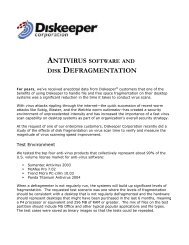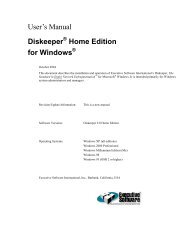Diskeeper 10 User's Manual
Diskeeper 10 User's Manual
Diskeeper 10 User's Manual
You also want an ePaper? Increase the reach of your titles
YUMPU automatically turns print PDFs into web optimized ePapers that Google loves.
64 Answers to Frequently Asked Questions<br />
The same situation applies to hiberfil.sys. When your system goes into hibernation mode, the pre-fetched disk<br />
locations are overwritten with the hibernation data. If <strong>Diskeeper</strong> moved hiberfil.sys out and moved other files<br />
into those disk locations, then disk corruption would occur.<br />
Why doesn't <strong>Diskeeper</strong> move all of the files into one place on the volume?<br />
Our primary philosophy with <strong>Diskeeper</strong> is improving and maintaining the performance of your computer. The<br />
disk drives are the primary bottleneck in your computer's performance. <strong>Diskeeper</strong> restores the disks to top<br />
speed by eliminating fragmentation.<br />
It is a common misconception that a defragmented disk should look very neat and tidy in the Volume Map tab,<br />
with solid blue bars all the way across the screen (representing fragmentation-free files) and the rest white<br />
space (representing consolidated space).<br />
Clearly, the speed of the volume (meaning how fast you can access the data on it) is more important than the<br />
prettiness of the display or the consolidation of all the free space into one place. Free space consolidation might<br />
be important if the next file that you plan to create needs to be one gigantic contiguous file, but it has no effect<br />
on performance. In fact, the operating system may or may not write the next file into a contiguous location<br />
even if there is a large enough space.<br />
Because of this, when using the “Quick” or “Recommended” defragmentation methods, <strong>Diskeeper</strong> uses<br />
algorithms that achieve the highest speed from your volumes regardless of the arrangement of the free spaces<br />
on the disk and on the screen—and it does so without wasting time on excessive consolidation of free space.<br />
We simply go for the fastest possible file access times and then stop.<br />
Even so, you might ask why we don't continue and rearrange the files further to get a neat display? Because it<br />
takes computer power to do so. We long ago decided that it would be wrong for <strong>Diskeeper</strong> to consume more of<br />
your computer's performance than it gives back. So <strong>Diskeeper</strong> defragments until the disk is in top shape<br />
performance-wise and then stops.<br />
Now this might not be important to you if you like to sit and watch the display as <strong>Diskeeper</strong> defragments your<br />
drive, but it is a very big deal to large corporate data centers and people who depend on their computers for<br />
their work. They need all the performance they can get and can't hold up production while the defragmenter<br />
works to enhance the "look" of the disk but not improve its performance. This is why <strong>Diskeeper</strong> is designed to<br />
run in the background at the lowest possible priority, giving way to any other program that needs to run. And it<br />
is also why <strong>Diskeeper</strong> stops defragmenting when maximum performance has been achieved.<br />
Of course, for those who want to expend the additional computer resources, the “Comprehensive”<br />
defragmentation method is also available. This defragmentation method performs additional processing to<br />
further consolidate the free space on your volumes.<br />
Can <strong>Diskeeper</strong> move directories?<br />
Windows NT 4.0 does not allow directories to be moved, because of data integrity issues related to how<br />
Windows NT maintains directory information. Since <strong>Diskeeper</strong> runs while other processes are active on the<br />
system, it does not attempt to move directories online.<br />
However, directories on Windows NT 4.0 volumes can be moved safely while your computer is being started—<br />
a time when Windows has not yet taken complete control of the files and directories on your disk. For more<br />
information on how to consolidate Windows NT 4.0 directories, see page 38.<br />
On Windows 98/Me computers, and NTFS volumes on Windows 2000, Windows XP, and Windows Server<br />
2003 systems, <strong>Diskeeper</strong> can safely move and defragment directories, which makes consolidation unnecessary.<br />
Can <strong>Diskeeper</strong> defragment paging files?<br />
<strong>Diskeeper</strong> does not defragment active paging files, since paging files must be open for exclusive use by<br />
Windows at all times. However, <strong>Diskeeper</strong> can defragment paging files safely when your computer is being<br />
started—a time when the operating system has not yet taken full control of the files and directories on your<br />
disk. For more information about defragmenting paging files, see page 38.






